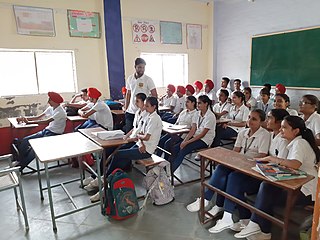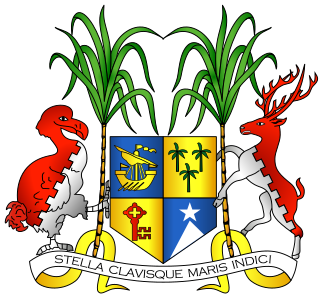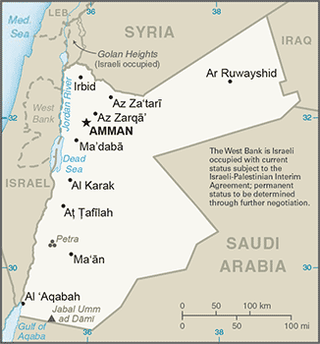
Barbados is an island country in the Lesser Antilles of the West Indies, in the Caribbean region of North America, and is the most easterly of the Caribbean islands. It lies on the boundary of the South American and the Caribbean Plates. Its capital and largest city is Bridgetown.

Education in India is primarily managed by the state-run public education system, which falls under the command of the government at three levels: central, state and local. Under various articles of the Indian Constitution and the Right of Children to Free and Compulsory Education Act, 2009, free and compulsory education is provided as a fundamental right to children aged 6 to 14. The approximate ratio of the total number of public schools to private schools in India is 10:3.

The parish of St. Michael is one of eleven parishes of Barbados. It has a land area of 39 km2 (15 sq mi) and is found at the southwest portion of the island. Saint Michael has survived by name as one of the original six parishes created in 1629 by Governor Sir William Tufton.

Education in Mauritius is managed by the Ministry of Education & Human Resources, which controls the development and administration of state schools funded by government, but also has an advisory and supervisory role in respect of private schools. The Tertiary education is maintained by the Ministry of Tertiary Education, Science, Research and Technology. The government of Mauritius provides free education to its citizens from pre-primary to tertiary levels. Since July 2005, the government also introduced free transport for all students. Schooling is compulsory up to the age of 16. Mauritian students consistently rank top in the world each year for the Cambridge International O Level, International A and AS level examinations. Among sub-Saharan African countries, Mauritius has one of the highest literacy rates. The adult literacy rate was at 91.9% in 2022. According to the 2022 census, the proportion of people with higher education has increased to 8.8%. Mauritius was ranked 57th in the Global Innovation Index in 2023, 1st in Africa.

Education in Nigeria is overseen by the Federal Ministry of Education. The local authorities take responsibility for implementing state-controlled policy regarding public education and state schools. The education system is divided into Kindergarten, Primary education, Secondary education, and Tertiary education. Nigeria's federal government has been dominated by instability since declaring independence from Britain, and as a result, a unified set of education policies is yet to be successfully implemented. Regional differences in quality, curriculum, and funding characterize the education system in Nigeria. Currently, Nigeria possesses the largest population of out-of-school learning youths in the world. The educational systems in Nigeria are divided into two the public where the student only pays for Parents Teachers Association (PTA) while the private where students pay school fees and some other fees like sports, exam fees, computer fees etc. and they are costly
Education in Tanzania is provided by both the public and private sectors, starting with pre-primary education, followed by primary, secondary ordinary, secondary advanced, and ideally, university level education. Free and accessible education is a human right in Tanzania. The Tanzanian government began to emphasize the importance of education shortly after its independence in 1961. Curriculum is standardized by level, and it is the basis for the national examinations. Achievement levels are important, yet there are various causes of children not receiving the education that they need, including the need to help families with work, poor accessibility, and a variety of learning disabilities. While there is a lack of resources for special needs education, Tanzania has committed to inclusive education and attention on disadvantaged learners, as pointed out in the 2006 Education Sector Review AIDE-MEMORE. The government's National Strategy for Growth and Reduction of Poverty in 2005 heavily emphasized on education and literacy.

The education system of the Hashemite Kingdom of Jordan includes basic, secondary, and higher education and has dramatically evolved since the establishment of the state in the early 1900s. The role played by a good education system has been significant in the development of Jordan from a predominantly agrarian to an industrialized nation over time.

Education in Guyana is provided largely by the Government of Guyana, through the Ministry of Education and its arms in the ten different regions of the country. Guyana's education system is a legacy from its time as British Guiana, and is similar to that of the other anglophone member states of the Caribbean Community, which are affiliated to the Caribbean Examinations Council (CXC). School curricula, funding, standards and other policies are set by the central government and implemented through the Ministry of Education and related agencies. The Education System is divided into eleven districts, ten of which correspond to the national administrative and geographical regions of the country, while the capital, Georgetown, is treated as a separate education district, district 11. With 8.3% of its GDP spent on education, Guyana sits with Cuba, Iceland, Denmark and Botswana as among the few countries with top spending on education.

Combermere School is a school in Barbados, notable as one of the oldest schools in the Caribbean, established in 1695. Its alumni include several leading cricketers, David Thompson, sixth prime minister of Barbados and other politicians, several authors and the singer Rihanna. In its first 75 years, the school "provided the Barbadian community with the vast bulk of its business leaders and civil servants" and it is "perhaps the first school anywhere to offer secondary education to black children".

Education in Somalia refers to the academic system within Somalia. The Ministry of Education is officially responsible for education in Somalia, with about 15% of the nation's budget allocated to scholastic instruction. The breakaway republic of Somaliland maintains its own advanced Ministry of Education.
Education in Trinidad and Tobago is free and is largely and primarily based on the British education system, compulsory between ages 5 and 16. Trinidad and Tobago is considered one of the most literate countries in the World with a literacy rate exceeding 98%. This exceptionally high literacy rate can be attributed, in part, to free tuition from Kindergarten (Pre-School) to University.
Education in Eswatini includes pre-school, primary, secondary and high schools, for general education and training (GET), and universities and colleges at tertiary level.
Harrison College is a co-educational grammar school in Bridgetown, Barbados. Founded in 1733, the school takes its name from Thomas Harrison, a Bridgetown merchant, who intended it to serve as "A Public and Free School for the poor and indigent boys of the parish".

Leah Janine Marville is a Barbadian TV Host, model and beauty pageant titleholder who won Miss Barbados World 2009.
The Barbados Community College is a tertiary institution located on Eyrie Howells' Road, Saint Michael, Barbados.
The Samuel Jackman Prescod Institute of Technology is a technical and vocational educational institution located in Pine Hill, Bridgetown, Barbados.
The Erdiston Teachers' Training College is located in Pine Hill, Bridgetown, Barbados. It is affiliated with the School of Education of the University of the West Indies, Cave Hill Campus.

University of the West Indies at Cave Hill is a public research university in Cave Hill, Barbados. It is one of five general campuses in the University of the West Indies system.
Monica Skeete was a Grenadian poet, writer and teacher. Her work was first published in the Barbadian literary magazine BIM in 1946. Her 1978 collection of short stories, Time Out, was published by Nelson Caribbean in their Authors of the Caribbean series, to support a growing educational market for Caribbean literature. Other short stories were anthologised in several publications. She also wrote novels. Much of her career was spent as a history teacher at Queen's College, Barbados. She died in 1997.












